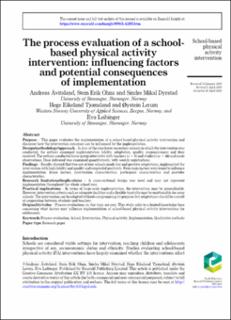| dc.contributor.author | Åvitsland, Andreas | |
| dc.contributor.author | Ohna, Stein Erik Solbø | |
| dc.contributor.author | Dyrstad, Sindre Mikal | |
| dc.contributor.author | Tjomsland, Hege Eikeland | |
| dc.contributor.author | Lerum, Øystein | |
| dc.contributor.author | Leibinger, Eva | |
| dc.coverage.spatial | Norway | en_US |
| dc.date.accessioned | 2020-06-18T08:28:00Z | |
| dc.date.available | 2020-06-18T08:28:00Z | |
| dc.date.created | 2020-06-08T09:33:27Z | |
| dc.date.issued | 2020 | |
| dc.identifier.citation | Åvitsland, A., Ohna, S. E., Dyrstad, S. M., Tjomsland, H. E., Lerum, Ø., & Leibinger, E. (2020). The process evaluation of a school-based physical activity intervention: influencing factors and potential consequences of implementation. Health Education. | en_US |
| dc.identifier.issn | 0965-4283 | |
| dc.identifier.uri | https://hdl.handle.net/11250/2658577 | |
| dc.description.abstract | Purpose
This paper evaluates the implementation of a school-based physical activity intervention and discusses how the intervention outcomes can be influenced by the implementation.
Design/methodology/approach
In four of the nine lower secondary schools in which the intervention was conducted, the authors examined implementation fidelity, adaptation, quality, responsiveness and dose received. The authors conducted focus group interviews with teachers (n = 8) and students (n = 46) and made observations. Dose delivered was examined quantitatively, with weekly registrations.
Findings
Results showed that two out of four schools made few and positive adaptations, implemented the intervention with high fidelity and quality and responded positively. Four main factors were found to influence implementation: frame factors, intervention characteristics, participant characteristics and provider characteristics.
Research limitations/implications
A cross-sectional design was used and may not represent implementation throughout the whole school year.
Practical implications
In terms of large-scale implementation, the intervention may be generalizable. However, intervention criteria such as adequate facilities and a flexible timetable may be unattainable for some schools. The intervention can be adapted without compromising its purpose, but adaptations should be a result of cooperation between students and teachers.
Originality/value
Process evaluations on this topic are rare. This study adds to a limited knowledge base concerning what factors may influence implementation of school-based physical activity interventions for adolescents. | en_US |
| dc.language.iso | eng | en_US |
| dc.publisher | Emerald | en_US |
| dc.rights | Navngivelse 4.0 Internasjonal | * |
| dc.rights.uri | http://creativecommons.org/licenses/by/4.0/deed.no | * |
| dc.subject | process evaluation | en_US |
| dc.subject | school | en_US |
| dc.subject | intervention | en_US |
| dc.subject | physical activity | en_US |
| dc.subject | implementation | en_US |
| dc.subject | qualitative methods | en_US |
| dc.title | The process evaluation of a school-based physical activity intervention: influencing factors and potential consequences of implementation | en_US |
| dc.type | Peer reviewed | en_US |
| dc.type | Journal article | en_US |
| dc.description.version | publishedVersion | en_US |
| dc.rights.holder | © Andreas Avitsland. Stein Erik Ohna, Sindre Mikal Dyrstad, Hege Eikeland Tjomsland, Øystein Lerum, Eva Leibinger. | en_US |
| dc.subject.nsi | VDP::Samfunnsvitenskap: 200::Samfunnsvitenskapelige idrettsfag: 330::Aktivitetslære: 332 | en_US |
| dc.source.journal | Health Education | en_US |
| dc.identifier.doi | 10.1108/HE-01-2020-0004 | |
| dc.identifier.cristin | 1814263 | |
| cristin.ispublished | true | |
| cristin.fulltext | original | |
| cristin.qualitycode | 1 | |

